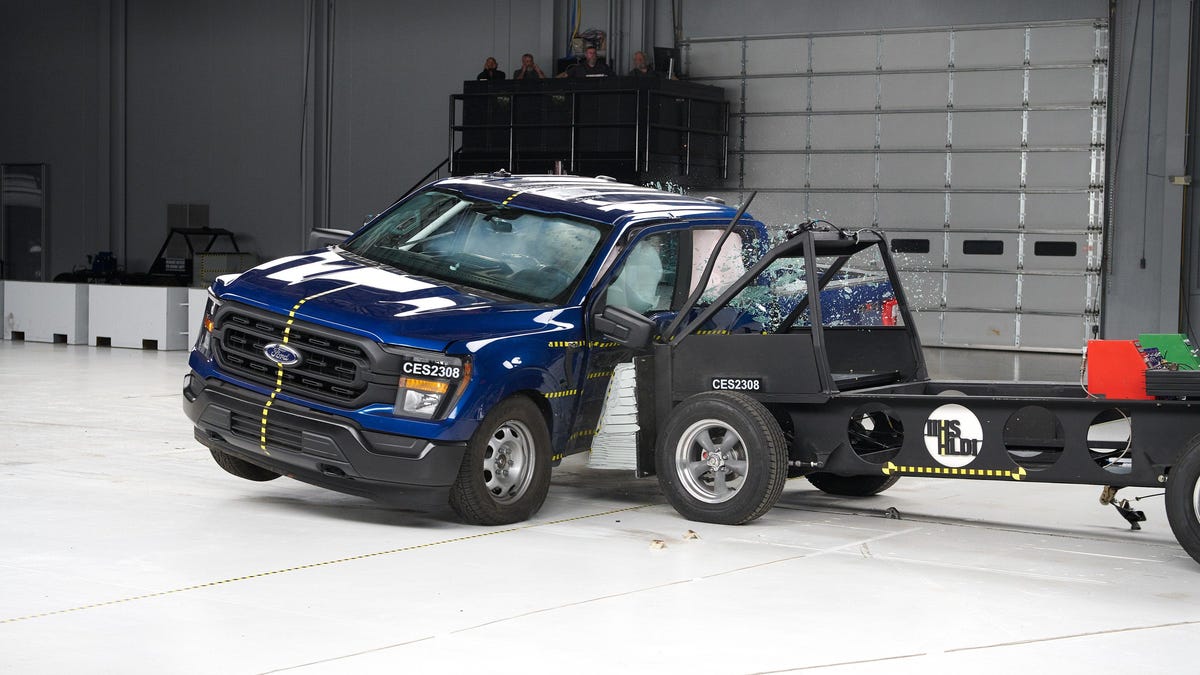Pickups are not as safe as most people would assume, at least not for passengers riding in the back seat of full size trucks. The 2023 Ford F-150, Chevy Silverado and Ram 1500 earned “poor” ratings in the latest IIHS crash safety test, which takes into account how well (or not) new vehicles protect rear passengers in the event of a collision.
Full size pickups are lauded for their perceived safety in a crash but it turns out big trucks are not as safe for those sitting in the back. These passengers are at greater risk of injury than front passengers and drivers, as shown by the results of the new moderate overlap front test from the IIHS. While safety has come a long way with modern restraint devices and airbags, these have helped drivers and front passengers most.
Kids usually ride in the second row of these new pickups since trucks have gone from being work vehicles to family cars in the U.S., where the F-150, Silverado and Ram are the best-selling vehicles year after year. And the IIHS updated their crash testing to focus on rear passengers because their safety has found to be lacking across vehicle segments, per the agency:
“Like most other vehicle classes, large pickups don’t perform as well in the new moderate overlap evaluation as they do in the updated side test, which is now a requirement for our TOP SAFETY PICK awards,” said IIHS President David Harkey.
IIHS launched the updated moderate overlap front test last year after research showed that in newer vehicles the risk of a fatal injury is now higher for belted occupants in the second row than for those in front. This is not because the second row has become less safe. Rather, the front seat has become safer because of improved airbags and advanced seat belts that are rarely available in back. Even with these developments, the back seat remains the safest place for children, who can be injured by an inflating front airbag, and the rating does not apply to children secured properly in child safety seats.
In the updated test, a second dummy is positioned in the second row behind the driver. The driver dummy is the size of an average adult man. The rear dummy is the size of a small woman or 12-year-old child. IIHS researchers also developed new metrics that focus on the injuries most frequently seen in back seat passengers.
The latest tests focused on four full size trucks from Ford, Chevy, Ram and Toyota. Midsize trucks have been found to provide less safety for rear passengers, and their bigger siblings now join them. In fact, the only full sizer that didn’t earn a poor rating on the tests overall was the 2023 Toyota Tundra.
Passengers in the Tundra were not subject to excessive seat belt forces in the back seat, unlike passengers in the F-150, Silverado and Ram trucks. But back seat passengers in all four trucks were at risk of “submarining,” which is when a passenger slides under the seat belt and risks injury due to being unrestrained.
For a vehicle to earn a good rating, there can’t be an excessive risk of injury to the head, neck, chest or thigh, as recorded by the second-row dummy. The dummy should remain correctly positioned during the crash without “submarining,” or sliding forward beneath the lap belt, which increases the risk of abdominal injuries. The head should also remain a safe distance from the front seatback and the rest of the vehicle interior, and the shoulder belt should remain on the shoulder, where it is most effective. A pressure sensor on the rear dummy’s torso is used to check the shoulder belt position during the crash.
[…]
Measurements taken from the rear dummy indicated that chest injuries and head or neck injuries would be likely in the F-150 and Ram 1500. The risk of those injuries was somewhat lower but still excessive in the Silverado. For the Tundra, the risk of chest injuries was also too high due to poor belt positioning, but the risk of head or neck injuries was only slightly elevated.
Big trucks are not alone in earning poor ratings for their back seat passengers, but the results are notable because many people take these trucks to be safer than other cars. Those anecdotal accounts have now unproven untrue.
Updated Tuesday, November 7 at 2:10 p.m. EST:
We reached out to automakers of the four full-size trucks included in the IIHS results. Ford representatives say the following:
Safety is a top priority, and the 2023 Ford F-150 meets or exceeds all current safety regulations and requirements. IIHS recently changed their moderate front overlap test procedure for the second row. We are always working to continuously improve and we consider IIHS and other third-party feedback in vehicle development. F-150 continues to achieve a “Good” overall rating in the original moderate overlap test for the front row and for the updated side impact test. F-150 also earned an IIHS 2022CY Top Safety Pick and the 2023 MY F-150 has a 5-star overall NHTSA rating, which is among the top on the market today.
While Chevy representatives say:
While we are very confident in the overall safety and crashworthiness of our light-duty Chevy Silverado crew cab, we appreciate what the IIHS has done with its new rear seat test protocols. IIHS findings are among the third-party inputs we value as we develop our products and continuously improve passenger safety.
We will update again if the remaining automakers respond.
![Image for article titled Full-Size Trucks From Ram, Ford And Chevy All Rated 'Poor' In IIHS Rear Seat Safety Test [Update]](https://i.kinja-img.com/image/upload/c_fit,q_60,w_645/386fac3499cd3a971660a08bf7308a2d.jpg)
![Image for article titled Full-Size Trucks From Ram, Ford And Chevy All Rated 'Poor' In IIHS Rear Seat Safety Test [Update]](https://i.kinja-img.com/image/upload/c_fit,q_60,w_645/369253abca765805c804d880f3eb3cb5.jpg)
![Image for article titled Full-Size Trucks From Ram, Ford And Chevy All Rated 'Poor' In IIHS Rear Seat Safety Test [Update]](https://i.kinja-img.com/image/upload/c_fit,q_60,w_645/3b69af89a936634c499a611205d71759.jpg)

